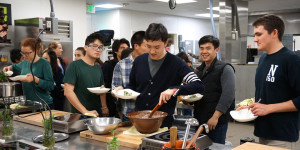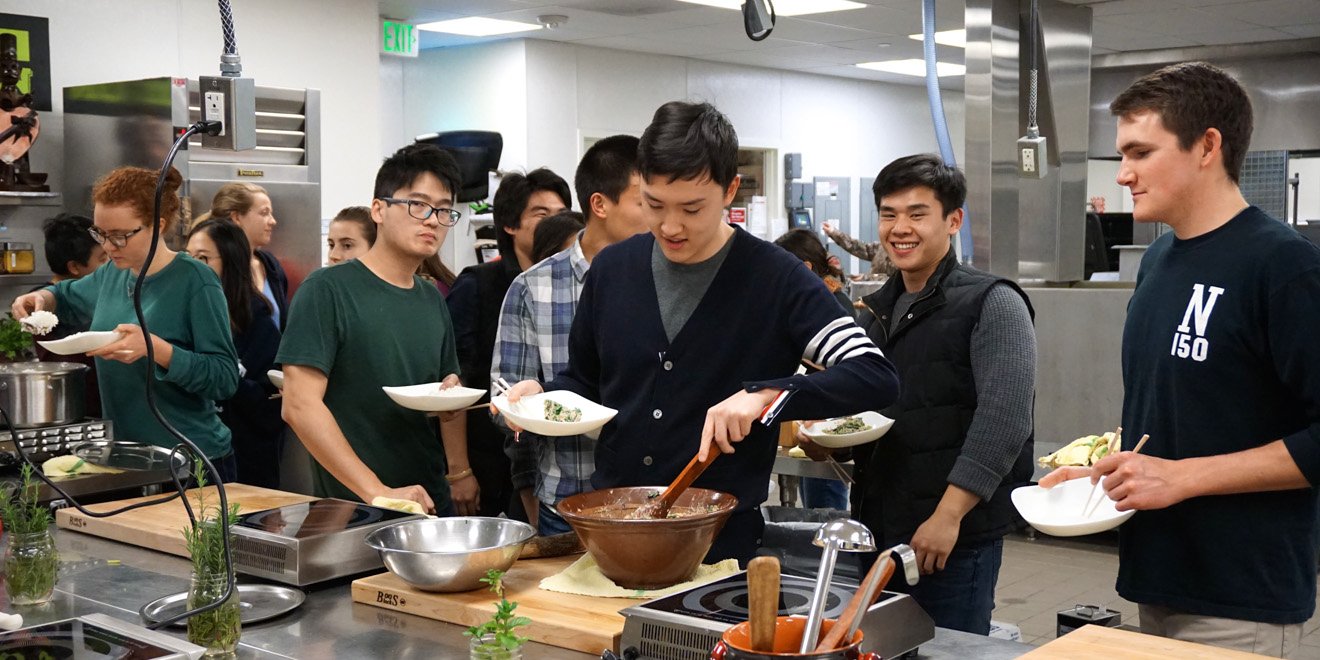
Stanford Cooking Society (SCS) invited author and alumna Nancy Singleton Hachisu ’78 to encourage student culinary activities by leading a hands-on cooking class on Japanese cuisine Monday night. The dinner menu consisted of country vegetable soup (kenchinjiru) and a miso hummus with brown rice featuring organic soy sauce (ohitashi). Students had the opportunity to use traditional Japanese knives for chopping.
SCS is a community of food enthusiasts who hold multiple workshops every quarter that are open to the student body. These workshops are either led by group members or by a professional member of the culinary community. Participants follow along with the designated instructor for each workshop and prepare the food. Sessions end with the group gathering to eat the meal.
According to co-president Ashley Ngu ’16, the group hopes to promote more cooking on campus, especially in the dorm kitchenettes, and teach students to prepare and eat healthy meals.
“[Learning to cook] is a way to learn about what you put into your body,” Ngu said. “You should eat diverse foods from good sources.”
While learning to cook the miso hummus, which consisted of ground-up walnuts, brown rice miso, rice vinegar and arugula, participants also discussed Japanese culture and cooking traditions, according to first-year master’s student Dan Sambor.
“We found out that [the Japanese] don’t use a lot of sauces because they like to keep the elegant balance between salt and rice,” Sambor said.
Hachisu grew up in the Bay Area and was the manager of the Toyon Eating Clubs during her time at Stanford. She came to the U.S. to promote her second book “Preserving the Japanese Way,” which discusses Japanese methods of salting, pickling and fermenting that can be integrated into Western cuisine.
“My books are not just about food, they are about community and life choices — following your heart as the path opens up in front of you,” her introductory email stated.
Hachisu has taught cooking classes for nearly 20 years in Japan and runs a children’s English immersion preschool called Sunny-Side Up!, which prepares home-cooked meals for its students. While in the U.S., her other goal is to connect with college-age students and dispel some common fears about cooking.
“I wanted the students to have this real experience,” Hachisu said. “If you make it too hyped up, asking for all these specific ingredients, people think they can’t do it.”
Although there are several opportunities to prepare food on campus, including the dorm kitchenettes, the cooperative houses, Residential & Dining Enterprises’ Jamie Oliver classes and student groups such as SCS, most undergraduates regularly eat in the dining halls. But according to workshop participant Anna Verwillow ’19, dorm kitchenettes remain a valued resource for baking and cooking among friends.
“Most people use the kitchenettes for baked goods, but there’s actually more cooking happening in college than I’d thought there would be,” she said.
While at Stanford, Hachisu prepared all of her own meals. She suggests that busy people, including college students, who want to eat healthy should make incremental changes in their diet instead of making drastic changes in one day.
“Simplify and get good ingredients,” Hachisu said. “It’s all about making the choices that work for you. And hopefully, you make better and better choices.”
Contact Ariel Liu at aliu15 ‘at’ stanford.edu.
